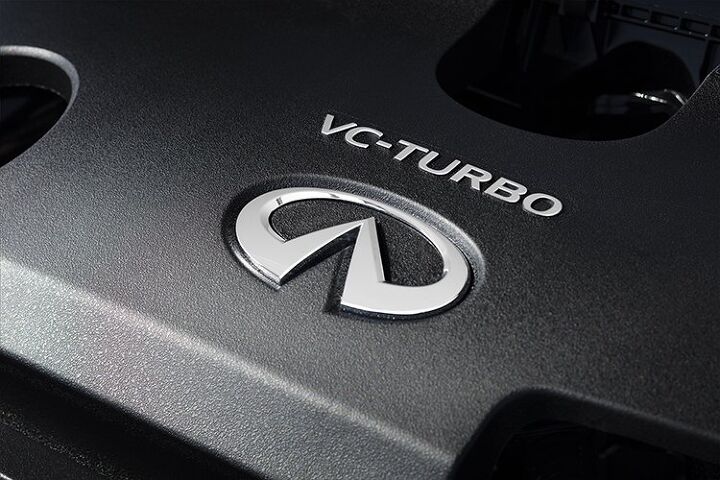Infiniti Wasn't Fibbing When It Estimated the Revolutionary QX50 Engine's Thirst

One thing is clear — with variable compression comes a newfound lack of thirst.
Infiniti’s previous midsize QX50 crossover didn’t astound in its thrift, garnering 20 miles per gallon on the EPA combined cycle. The move to a new, front-drive platform and addition of a years-in-the-making gasoline engine for 2019 has done wonders for the model’s drinking habit, however, and Infiniti engineers pegged the MPG figures right on the nose.
With the 2019 QX50‘s fuel economy now confirmed by the EPA, it begs the question: just how much of the model’s thriftiness can the variable compression engine take credit for?
By adopting a turbocharged 2.0-liter four-cylinder with revolutionary internals, the front-drive 2019 QX50 delivers 27 mpg combined, 24 in the city, and 31 on the highway. Shave off 1 mpg from the highway and combined figures for the all-wheel-drive model.
This is exactly the estimated 35 percent (FWD) and 30 percent (AWD) increase in fuel economy touted by Infiniti reps at a recent first drive event. Last year, chief powertrain engineer Shinichi Kiga said the VC-T engine would help the new QX50 top the old one by 27 percent on the combined cycle.
To put the mileage into perspective, Acura’s MDX Sport Hybrid, available only in AWD, rates 27 mpg on the combined cycle. But the Infiniti, devoid of any pricey electrical trappings, beats it by 3 mpg on the highway.
It would be interesting — and informative — to see an engine swap performed on an existing model, with no other changes. That’s because, for 2019, the QX50 donned more than just a new skin and beating heart. Its engine went from a 3.7-liter naturally aspirated V6 to a turbocharged four-banger designed to make up for the lost displacement with varying piston reach. Horsepower shrunk from 325 to 268, with torque seeing a boost from 267 to 280 lb-ft.
While engineers shaved some weight from the new model, the lost heft didn’t amount to more than 100 pounds. The previous seven-speed automatic transmission also disappeared in favor of a continually variable unit programmed with economy in mind. It’s no secret CVTs are the go-to ‘box for ultra-thrifty models, but combined MPG gains well into the double digits are not something you’ll attain with a simple tranny swap.
In the absence of significant lightweighting, the new engine looks to be the main culprit. It’s certainly a win for Infiniti engineers and the brand itself, but it remains to be seen if the new engine (and styling) helps win the QX50 more fans than the previous-generation model, which never became a huge player in the all-important premium crossover segment.
As for reliability, we can only trust Infiniti did its homework there, too.
[Images: Infiniti]

More by Steph Willems
Latest Car Reviews
Read moreLatest Product Reviews
Read moreRecent Comments
- Brendan Duddy soon we'll see lawyers advertising big payout$ after getting injured by a 'rogue' vehicle
- Zerofoo @VoGhost - The earth is in a 12,000 year long warming cycle. Before that most of North America was covered by a glacier 2 miles thick in some places. Where did that glacier go? Industrial CO2 emissions didn't cause the melt. Climate change frauds have done a masterful job correlating .04% of our atmosphere with a 12,000 year warming trend and then blaming human industrial activity for something that long predates those human activities. Human caused climate change is a lie.
- Probert They already have hybrids, but these won't ever be them as they are built on the modular E-GMP skateboard.
- Justin You guys still looking for that sportbak? I just saw one on the Facebook marketplace in Arizona
- 28-Cars-Later I cannot remember what happens now, but there are whiteblocks in this period which develop a "tick" like sound which indicates they are toast (maybe head gasket?). Ten or so years ago I looked at an '03 or '04 S60 (I forget why) and I brought my Volvo indy along to tell me if it was worth my time - it ticked and that's when I learned this. This XC90 is probably worth about $300 as it sits, not kidding, and it will cost you conservatively $2500 for an engine swap (all the ones I see on car-part.com have north of 130K miles starting at $1,100 and that's not including freight to a shop, shop labor, other internals to do such as timing belt while engine out etc).



































Comments
Join the conversation
The MDX hybrid is geared toward performance over outright fuel economy. It's also bigger and heavier. The Lexus RX 450h is closer and rates 30 mpg combined.
Nightmare engine guts, unproven durability plus CVT? Nissan?! The only way for that combination to be worse is substitute "Nissan" with something German. A neat experiment, but I feel long term reliability is questionable.